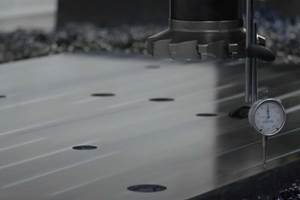Makino offers the F8 and F9 machines with its line of F-Series vertical machining centers. Big mold and die components may test the work-weight capacity of most machines, and they could pose a unique dilemma for high-speed machining techniques and the accuracy capability; and, large production parts present challenges due to the size and range of the part. Designed for power, speed, precision and versatility, the F8 and F9 are built to meet these divergent manufacturing needs in both the die and mold and large part production markets.
The smaller F8 features X-, Y- and Z-axis travels of 51.2 inches, 31.5 inches and 25.6 inches, respectively, a 61-inch-by-31.5-inch table and a maximum workpiece size of 61 inches long by 31.5 inches wide by 21.7 inches tall. By contrast, the larger F9 features X-, Y- and Z-axis travels of 63 inches, 31.5 inches and 25.6 inches, respectively, a 72.8-inch-by-31.5-inch table and a maximum workpiece size of 72.8 inches long by 31.5 inches wide by 21.7 inches tall. Both machines offer a payload capacity of 5,510 pounds and feature a 30-tool capacity automatic tool changer.
Changing full-size workpieces can dramatically impact large machine utilization, productivity and ultimately part costs. Therefore, the F8 and F9 incorporate a unique, dual sliding door, chip- and splash-guard design for simplified loading and unloading of large workpieces. The open-corner, open-ceiling design affords unparalleled access for setups and changeovers, improving work in progress (WIP) and overall lead-times.
The F8 and F9 vertical machining centers offer a number of spindle configurations for tailoring the machine to specific die/mold or production applications.
The standard spindle configuration is a 49.6-hp, 10,000-rpm, CAT 50 spindle. As an option, the spindle can also be provided with an HSK-A100 spindle interface. With 315 ft-lbs of torque, this combination provides stiffness and rigidity for lower-speed roughing operations and an excellent mix of spindle speed, power and torque.
As an option, the F8 and F9 can be equipped with a 40.2-hp, 20,000-rpm, HSK-A63 spindle. This configuration provides the vibration-free, chatter-free, high-ranging spindle speeds required for efficient high-speed hardmilling of small details and fine surface finishes typical of the die/mold market.
The standard coolant system provides a combination of nozzle flood coolant, flush coolant, through-spindle air and an external air-blow nozzle. Dual internal spiral chip conveyors quickly and efficiently move chips and coolant to the rear of the machine, discharging them into a scraper-drum lift-up chip conveyor. Various, optional through-spindle coolant systems can be provided to further enhance the capability and performance of the machine.
The F8 and F9 vertical machining centers employ the Makino Professional 5 Control, which affords the perfect balance of a Windows CE graphical user interface (GUI), touch-screen selection offering instant access to information at one’s fingertips, user-friendly, efficient PC-like capability for data management and editing, and the networking and storage capability of a data center.
As an option, the machine can be arranged with Makino’s proprietary, next-generation Super Geometric Intelligence (SGI.4) software developed specifically for high-feedrate, tight-tolerance machining of complex, 3-D contoured shapes involving continuous, tiny blocks of NC data that ensure production rates faster than standard CNC systems while maintaining high accuracy. SGI.4 helps provide the lowest cycle times and costs achievable by reducing machining cycle times by as much as 40 percent when compared to most other control technologies.
Related Content
How to Produce More Accurate Molds and Reduce Rework
Patented micro-milling process for manufacturing steel plate flat and parallel helps mold builders shorten mold build times and increase accuracy.
Read MoreMachining Center Spindles: What You Need to Know
Why and how to research spindle technology before purchasing a machining center.
Read MoreMoldmakers Deserve a Total Production Solution
Stability, spindle speed and software are essential consideration for your moldmaking machine tool.
Read MoreHow to Analyze and Optimize Cutting Conditions to Reduce Cycle Time
Plastic injection mold design and manufacturing company puts NC program optimization software module to the test. The results were surprising.
Read MoreRead Next
How to Use Continuing Education to Remain Competitive in Moldmaking
Continued training helps moldmakers make tooling decisions and properly use the latest cutting tool to efficiently machine high-quality molds.
Read MoreReasons to Use Fiber Lasers for Mold Cleaning
Fiber lasers offer a simplicity, speed, control and portability, minimizing mold cleaning risks.
Read MoreHow to Use Strategic Planning Tools, Data to Manage the Human Side of Business
Q&A with Marion Wells, MMT EAB member and founder of Human Asset Management.
Read More

























